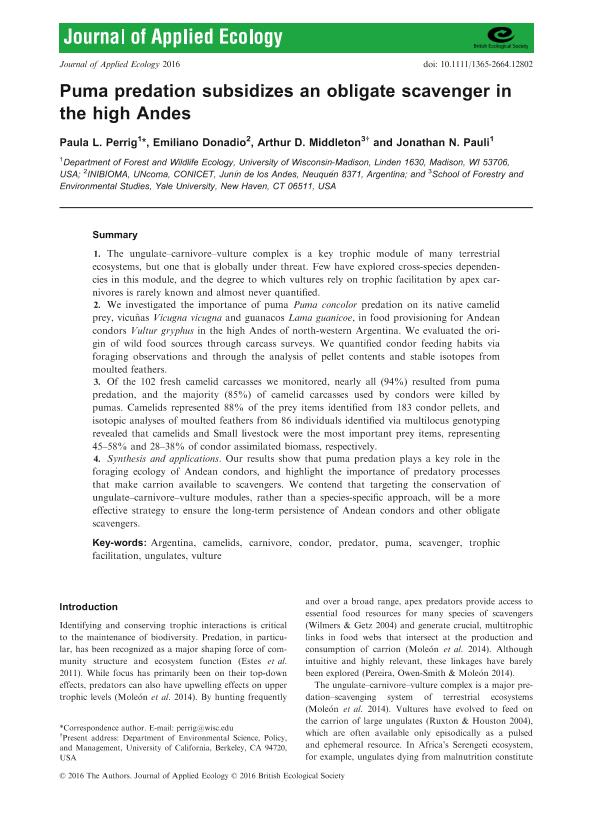Mostrar el registro sencillo del ítem
dc.contributor.author
Perrig, Paula L.
dc.contributor.author
Donadio, Emiliano

dc.contributor.author
Middleton, Arthur D.
dc.contributor.author
Pauli, Jonathan Nicholas

dc.date.available
2018-06-21T20:53:02Z
dc.date.issued
2017-06-30
dc.identifier.citation
Perrig, Paula L.; Donadio, Emiliano; Middleton, Arthur D.; Pauli, Jonathan Nicholas; Puma predation subsidizes an obligate scavenger in the high Andes; Wiley Blackwell Publishing, Inc; Journal of Applied Ecology; 54; 3; 30-6-2017; 846-853
dc.identifier.issn
0021-8901
dc.identifier.uri
http://hdl.handle.net/11336/49602
dc.description.abstract
The ungulate–carnivore–vulture complex is a key trophic module of many terrestrial ecosystems, but one that is globally under threat. Few have explored cross-species dependencies in this module, and the degree to which vultures rely on trophic facilitation by apex carnivores is rarely known and almost never quantified. We investigated the importance of puma Puma concolor predation on its native camelid prey, vicuñas Vicugna vicugna and guanacos Lama guanicoe, in food provisioning for Andean condors Vultur gryphus in the high Andes of north-western Argentina. We evaluated the origin of wild food sources through carcass surveys. We quantified condor feeding habits via foraging observations and through the analysis of pellet contents and stable isotopes from moulted feathers. Of the 102 fresh camelid carcasses we monitored, nearly all (94%) resulted from puma predation, and the majority (85%) of camelid carcasses used by condors were killed by pumas. Camelids represented 88% of the prey items identified from 183 condor pellets, and isotopic analyses of moulted feathers from 86 individuals identified via multilocus genotyping revealed that camelids and Small livestock were the most important prey items, representing 45–58% and 28–38% of condor assimilated biomass, respectively. Synthesis and applications. Our results show that puma predation plays a key role in the foraging ecology of Andean condors, and highlight the importance of predatory processes that make carrion available to scavengers. We contend that targeting the conservation of ungulate–carnivore–vulture modules, rather than a species-specific approach, will be a more effective strategy to ensure the long-term persistence of Andean condors and other obligate scavengers.
dc.format
application/pdf
dc.language.iso
eng
dc.publisher
Wiley Blackwell Publishing, Inc

dc.rights
info:eu-repo/semantics/openAccess
dc.rights.uri
https://creativecommons.org/licenses/by-nc-sa/2.5/ar/
dc.subject
Argentina
dc.subject
Camelids
dc.subject
Carnivore
dc.subject
Condor
dc.subject
Predator
dc.subject
Puma
dc.subject
Scavenger
dc.subject
Trophic Facilitation
dc.subject
Ungulates
dc.subject
Vulture
dc.subject.classification
Otras Ciencias Biológicas

dc.subject.classification
Ciencias Biológicas

dc.subject.classification
CIENCIAS NATURALES Y EXACTAS

dc.title
Puma predation subsidizes an obligate scavenger in the high Andes
dc.type
info:eu-repo/semantics/article
dc.type
info:ar-repo/semantics/artículo
dc.type
info:eu-repo/semantics/publishedVersion
dc.date.updated
2018-06-06T21:01:24Z
dc.journal.volume
54
dc.journal.number
3
dc.journal.pagination
846-853
dc.journal.pais
Reino Unido

dc.journal.ciudad
Londres
dc.description.fil
Fil: Perrig, Paula L.. University of Wisconsin; Estados Unidos
dc.description.fil
Fil: Donadio, Emiliano. Consejo Nacional de Investigaciones Científicas y Técnicas. Centro Científico Tecnológico Conicet - Patagonia Norte. Instituto de Investigaciones en Biodiversidad y Medioambiente. Universidad Nacional del Comahue. Centro Regional Universidad Bariloche. Instituto de Investigaciones en Biodiversidad y Medioambiente; Argentina
dc.description.fil
Fil: Middleton, Arthur D.. University of Yale; Estados Unidos
dc.description.fil
Fil: Pauli, Jonathan Nicholas. University of Wisconsin; Estados Unidos
dc.journal.title
Journal of Applied Ecology

dc.relation.alternativeid
info:eu-repo/semantics/altIdentifier/url/http://onlinelibrary.wiley.com/doi/10.1111/1365-2664.12802/abstract
dc.relation.alternativeid
info:eu-repo/semantics/altIdentifier/doi/http://dx.doi.org/10.1111/1365-2664.12802
Archivos asociados
